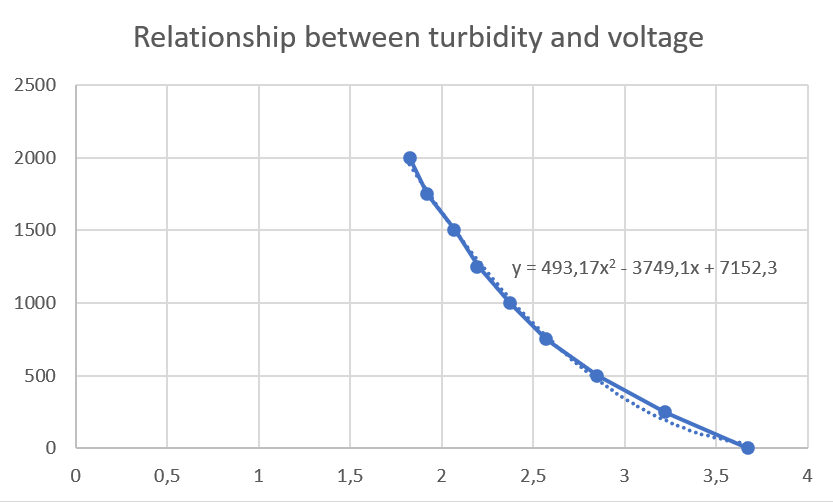Hi all,
I am working on a project where I am trying to use the Grove turbidity sensor with an ESP32. The specific datasheet for the sensor can be found here (https://files.seeedstudio.com/products/101020752/Turbidity%20Sensor%20specification.pdf).
I have powered the sensor externally with a 5V supply, and in my code, I’m currently using the 3.3V operating voltage with the 4096 resolution of the ESP32. Unfortunately, I don’t have any calibration liquid to calibrate the sensor.
I’ve noticed that other manufacturers, like DF Robot, provide a specific formula for their sensors. For example, the formula given by DF Robot is: y = -1120.4 * x^2 + 5742.3 * x - 4352.9.
My question is, does anyone know of a corresponding formula for the Grove sensor that aligns with the information provided in the datasheet? I’m having difficulty getting accurate readings without it. Any assistance or guidance would be greatly appreciated.
Currently, I’m trying to read the values linearly from 0 to 3.3V, but I suspect this approach might be too imprecise for my needs. Here’s the code I’m using which I adjust and found here:(Turbidity sensor coding - #3 by zhomeslice - Programming Questions - Arduino Forum)
cppCopy code
#include <EEPROM.h> // to store last calibration value (blank, Vclear)
int sensor = 0; // variable for averaging
int n = 25; // number of samples to average
int sensorValue = 0;
float voltage = 0.00;
float turbidity = 0.00;
float Vclear = 3.3; // Output voltage to calibrate (with clear water).
void setup()
{
Serial.begin(115200);
EEPROM.get(0, Vclear); // recovers the last Vclear calibration value stored in ROM.
delay(3000); // Pause for 3 seconds
}
void loop()
{
// Sensing routine:
for (int i = 0; i < n; i++) {
sensor += analogRead(A3); // read the input on analog pin 3 (turbidity sensor analog output)
delay(10);
}
sensorValue = sensor / n; // average the n values
voltage = sensorValue * (3.300 / 4095.000); // Convert analog (0-4095) to voltage (0 - 3.3V)
turbidity = 20.00 * (100.00 - (voltage / Vclear) * 100.00); // as relative percentage of 2000 NTU; 0% = clear water; // Factor 20 at the front instead of 100 to limit the result to 2000
// Serial display
Serial.print("Raw voltage: ");
Serial.print(voltage, 3);
Serial.print(" V, Turbidity: ");
Serial.print(turbidity, 3);
Serial.println(" NTU");
sensor = 0; // resets for averaging
delay(1000); // Pause for 1 seconds. // sampling rate
}
I’m hoping that someone may have experience with this sensor and can provide insight or guidance on a more accurate method for reading turbidity. If there is a specific formula that can be applied to the Grove sensor, that would be incredibly helpful.
Thanks in advance!
